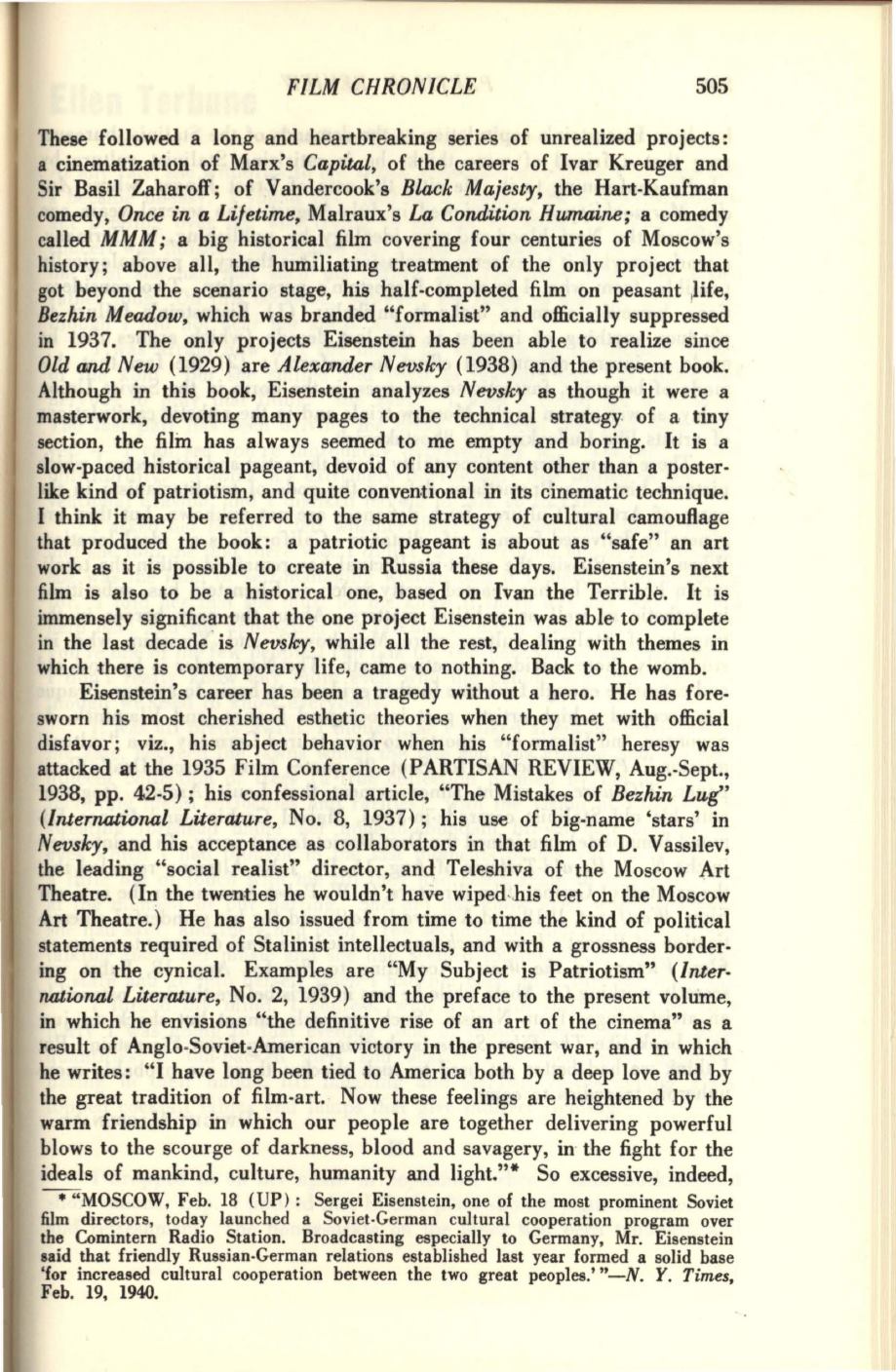
FILM CHRONICLE
505
These followed a long and heartbreaking series of unrealized projects:
a cinematization of Marx's
Capital,
of the careers of lvar Kreuger and
Sir Basil Zaharoff; of Vandercook's
Black Majesty,
the Hart-Kaufman
comedy,
Once in a Lifetime,
Malraux's
La
Condition HUTTI.aine;
a comedy
called
MMM;
a big historical film covering four centuries of Moscow's
history; above all, the humiliating treatment of the only project that
got beyond the scenario stage, his half-completed film on peasant ilife,
Bezhin Meadow,
which was branded "formalist" and officially suppressed
in 1937. The only projects Eisenstein has been able to realize since
Old
and New
(1929) are
Alexander
Nevsky
(1938) and the present book.
Although in this book, Eisenstein analyzes
Nevsky
as though it were a
masterwork, devoting many pages to the technical strategy. of a tiny
section, the filin has always seemed to me empty and boring. It is a
slow-paced historical pageant, devoid of any content other than a poster·
like kind of patriotism, and quite conventional in its cinematic technique.
I think
it
may be referred to the same strategy of cultural camouflage
that produced the book: a patriotic pageant is about as "safe" an art
work as it is possible to create in Russia these days. Eisenstein's next
film
is also to be a historical one, based on Ivan the Terrible. It is
immensely significant that the one project Eisenstein was able to complete
in the last decade ·is
Nevslcy,
while all the rest, dealing with themes in
which there is contemporary life, came to nothing. Back to the womb.
Eisenstein's career has been a tragedy without a hero. He has fore–
sworn his most cherished esthetic theories when they met with official
disfavor; viz., his abject behavior when his "formalist" heresy was
attacked at the 1935 Film Conference (PARTISAN REVIEW, Aug.-Sept.,
1938, pp. 42-5) ; his confessional article, "The Mistakes of
Bezhin Lug'
(lnternalional Literature,
No. 8, 1937) ; his use of big-name 'stars' in
Nevsky,
and his acceptance as collaborators in that film of D. Vassilev,
the leading "social realist" director, and Teleshiva of the Moscow ..:\rt
Theatre. (In the twenties he wouldn't have wiped-.his feet on the Moscow
Art Theatre.) He has also issued from time to time the kind of political
statements required of Stalinist intellectuals, and with a grossness border–
ing on the cynical. Examples are "My Subject is Patriotism"
(lnter–
ruuional Literature,
No. 2, 1939) and the preface to the present volrime,
in which he envisions "the definitive rise of an art of the cinema" as a
result of Anglo-Soviet-American victory in the present war, and in which
he writes: "I have long been tied to America both by a deep love and by
the great tradition of film-art. Now these feelings are heightened by the
warm friendship in which our people are together delivering powerful
blows to the scourge of darkness, blood and savagery, in· the fight for the
ideals of mankind, culture, humanity and light."* So excessive, indeed,
---.--..MOSCOW, Feb. 18 (UP) : Sergei Eisenstein, one of the most prominent Soviet
film directors, today launched a Soviet-German cultural cooperation program over
the Comintern Radio Station. Broadcasting especially to Germany, Mr. Eisenstein
said that friendly Russian-German relations established last year formed a solid base
'for increased cultural cooperation between the two great peoples.'
"-N. Y. Times,
Feb. 19, 1940.


